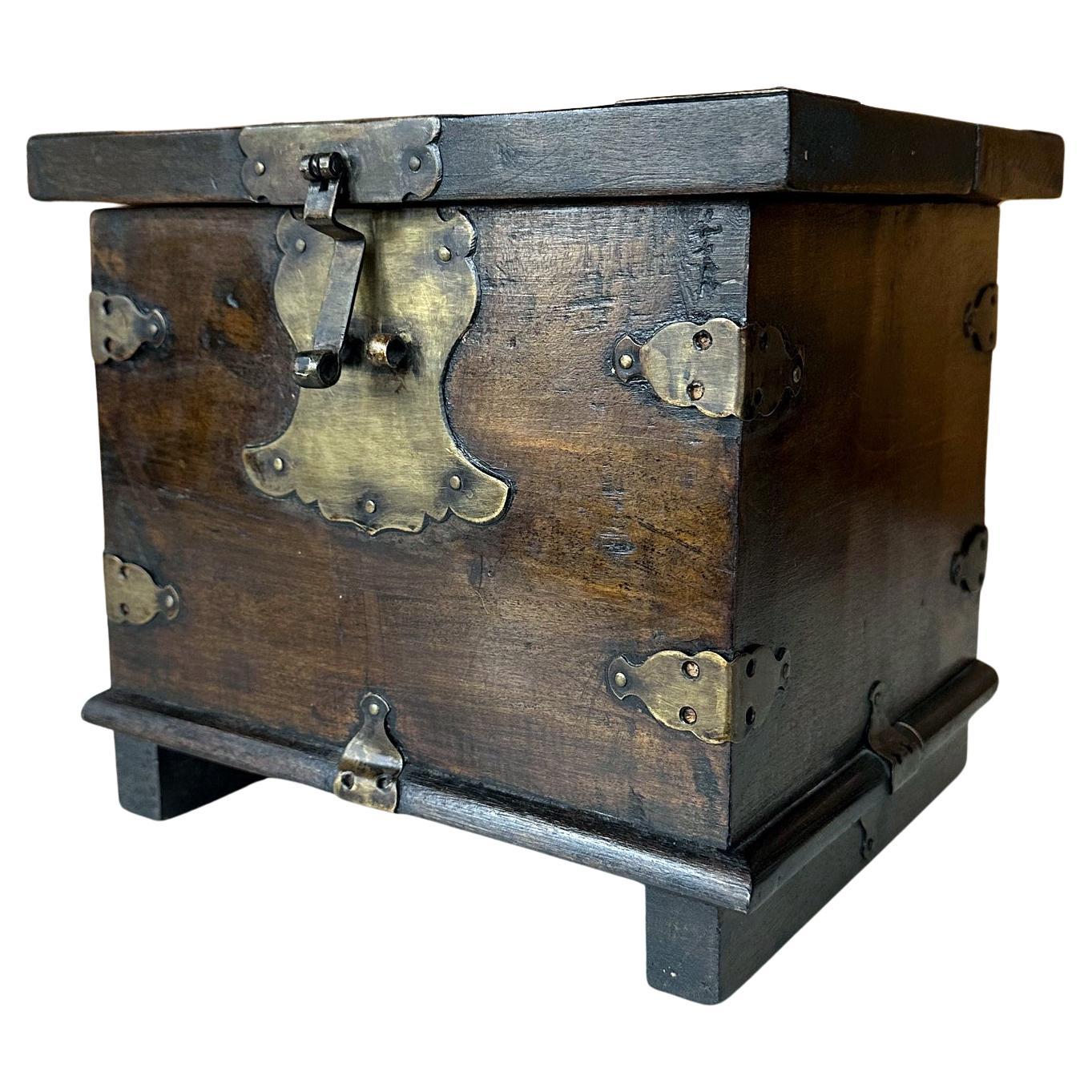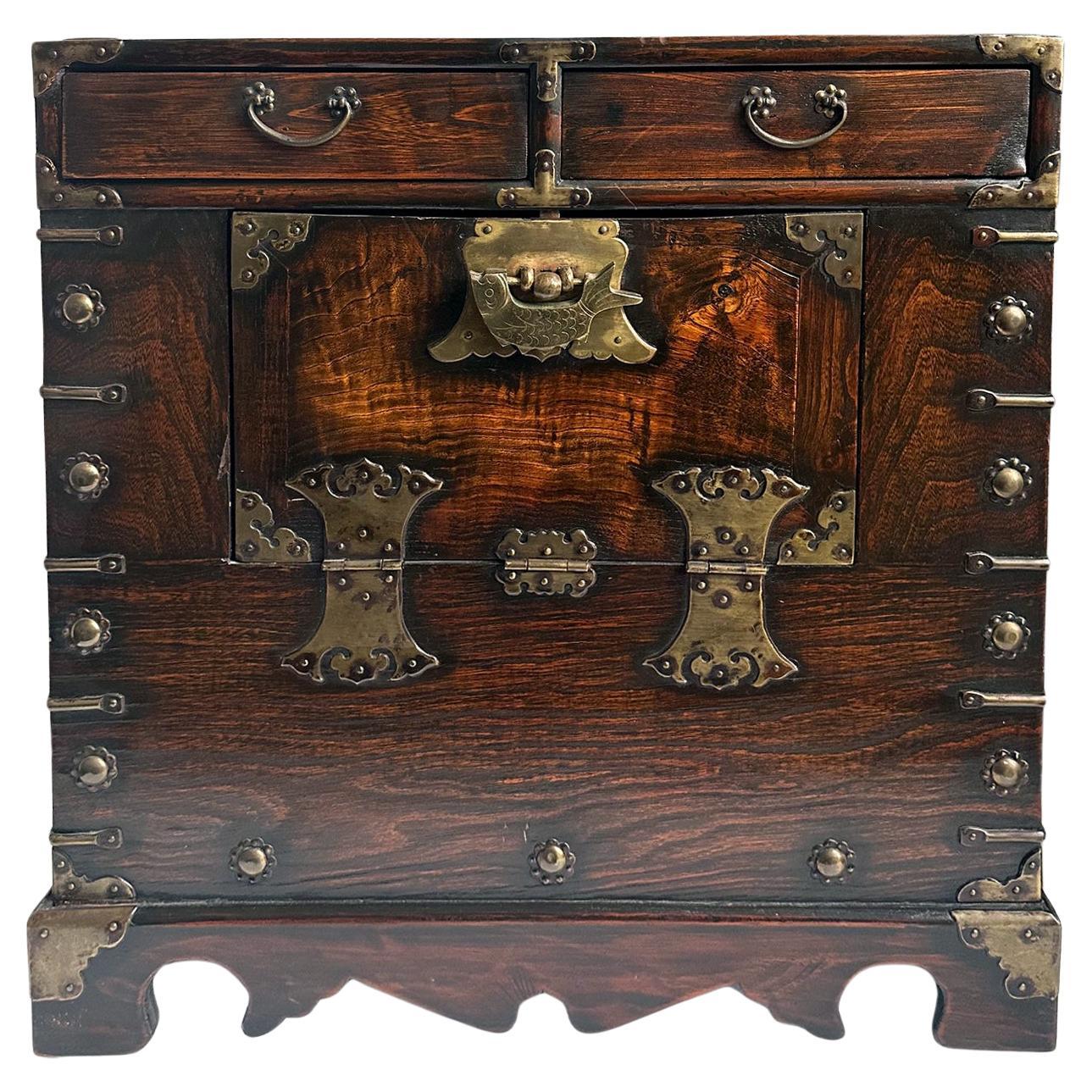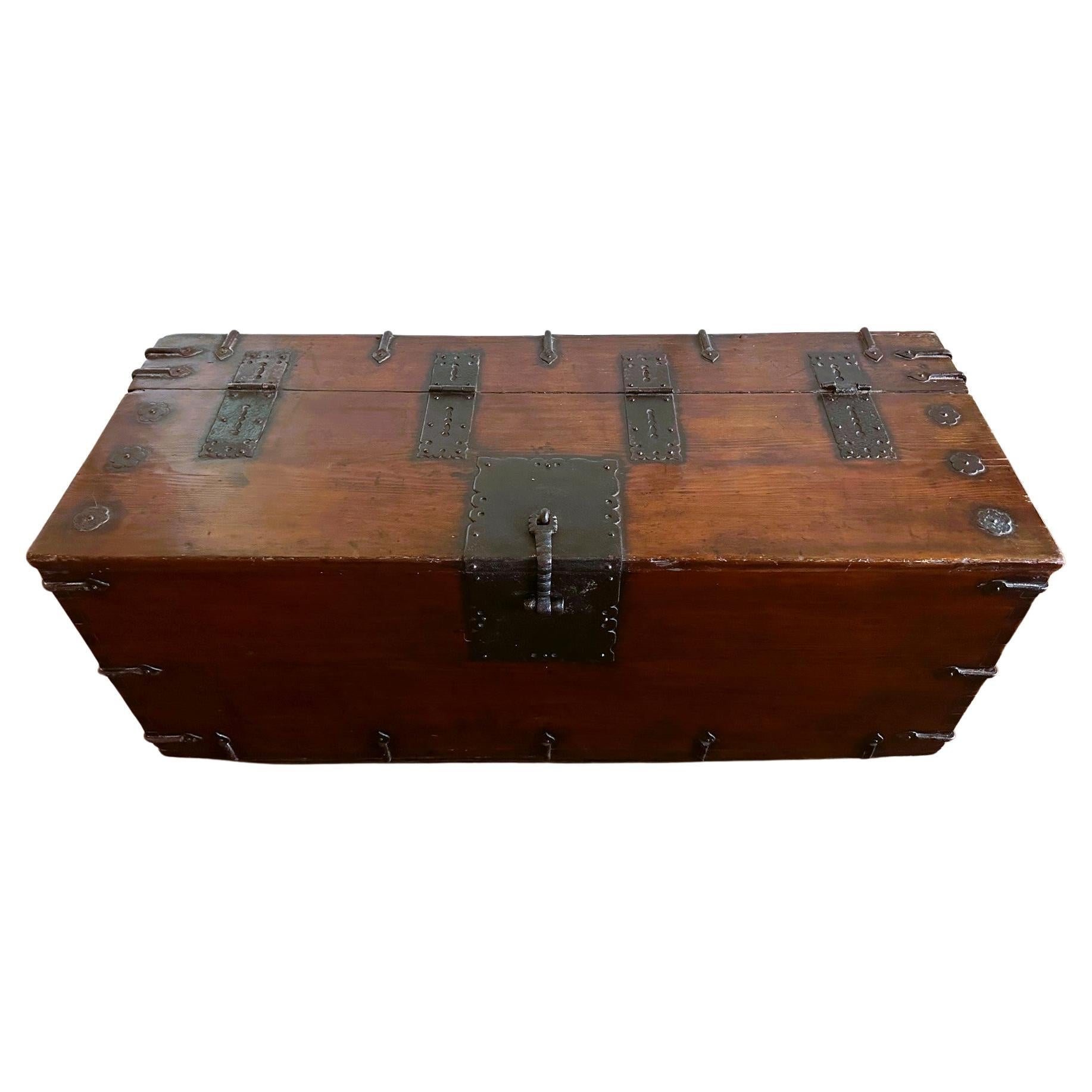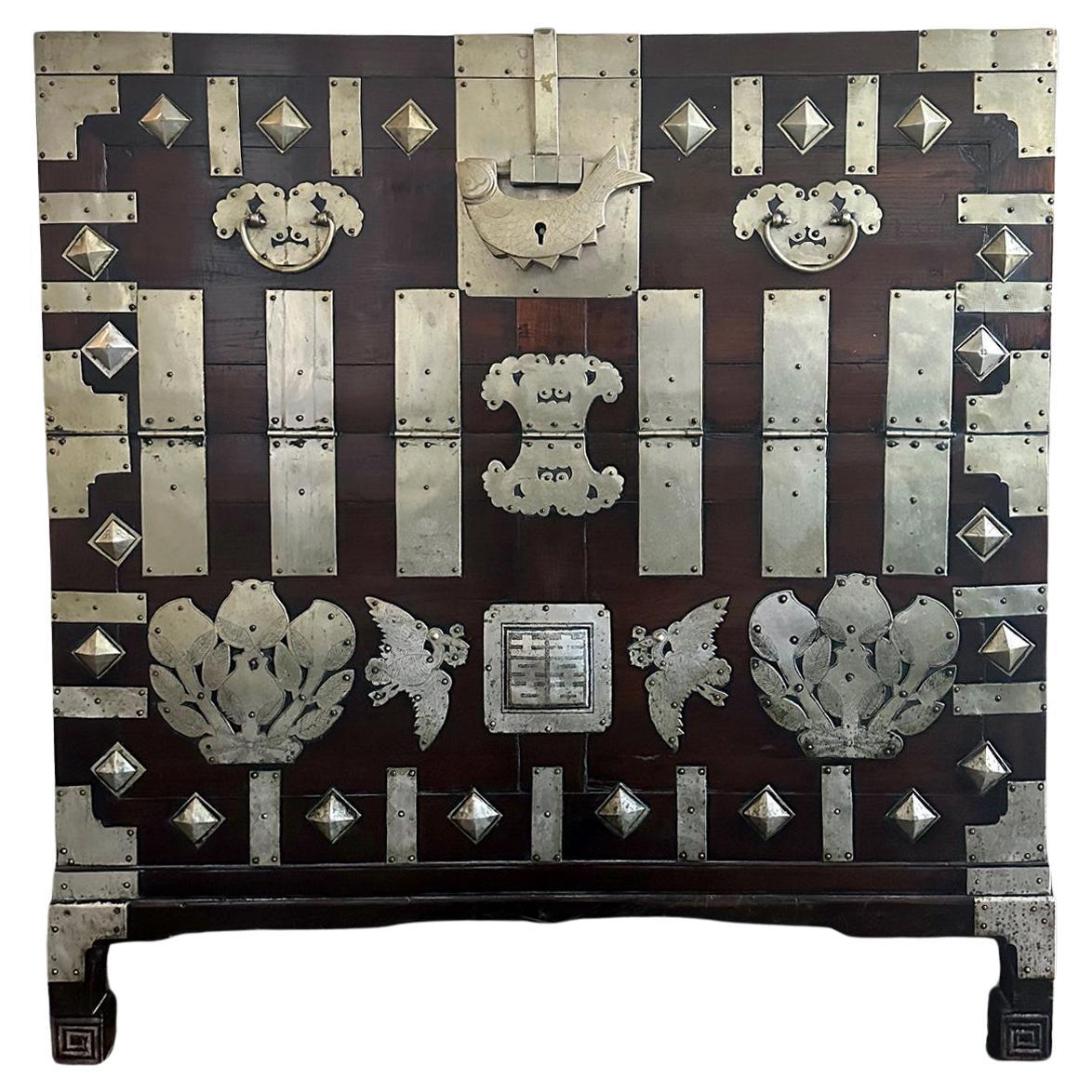Items Similar to Korean Book Shelf Etagere Late Joseon Dynasty
Want more images or videos?
Request additional images or videos from the seller
1 of 17
Korean Book Shelf Etagere Late Joseon Dynasty
About the Item
Known in Korean as Sabang Takja (Four-Direction Shelf), this cubic etagere consists of four tiers: three open shelves and the lower storage, which is further divided into a row of three small drawers and a bottom storage space with doors. With its simple and elegant form, this is an important piece of furniture for an affluent household and was used to display priced processions. Books, curios, porcelains and scholar objects would be showcased to the guest as a reflection of the culture of the owners. The current Sabang Takja was dated to the end of Joseon Dynasty (1890-1900s and the frame and the shelves were made from a hardwood (possibly paulownia or pear wood, but due to the lacquered surface that obscure the grains, it was not possible to tell what type exactly) and persimmon wood was used for the frontal panels of the three drawers and the pair of the small doors on the lower part. Yellow brass hardware was used for the drawer pulls and the decorative butterfly hinges and door latch. Copper alloy brackets were placed on the corner of the shelves. The persimmon wood showcases an eye-catching black grain, like an abstract painting. Since the tree was more common in the southern Korean peninsula, the piece was most likely from the south.
A similar sabang takja from Gyeonggi Province was in the collection of Weisman Art Musuem (1989.7.66), illustrated 125 on page 97 in "Traditional Korean Furniture" by Edward Reynolds Wright and Man Sill Pai.
Another example is Gu 3679 in the collection of National Museum of Korea.
- Dimensions:Height: 65.75 in (167.01 cm)Width: 21.5 in (54.61 cm)Depth: 15.5 in (39.37 cm)
- Style:Other (Of the Period)
- Materials and Techniques:
- Place of Origin:
- Period:1900-1909
- Date of Manufacture:1890-1910s
- Condition:Wear consistent with age and use. Overall good antique condition in keeping with age. Minor scattered scratches and small bumps on the edges throughout. Heavy wear, scratches and dark patina on the yellow brass hardware as shown.
- Seller Location:Atlanta, GA
- Reference Number:1stDibs: LU945035905142
About the Seller
5.0
Platinum Seller
These expertly vetted sellers are 1stDibs' most experienced sellers and are rated highest by our customers.
Established in 2006
1stDibs seller since 2010
479 sales on 1stDibs
Typical response time: <1 hour
- ShippingRetrieving quote...Ships From: Atlanta, GA
- Return PolicyA return for this item may be initiated within 2 days of delivery.
More From This SellerView All
- Antique Korean Small Wood Box Joseon DynastyLocated in Atlanta, GAA small Korean antique box circa late 19th century of Joseon Dynasty. The square form box was constructed with thick hardwood planks on all side (appears to be elm) with a noticeable...Category
Antique 19th Century Korean Other Furniture
MaterialsBrass
- Korean Headside Storage Cabinet Morijang Joseon DynastyLocated in Atlanta, GAA small Korean wood cabinet dated to the late Joseon Dynasty circa 19th century. The cabinet was known as "Morijang" in Korean and was traditionally used to keep valuables such as je...Category
Antique 19th Century Korean Other Furniture
MaterialsBrass
- Antique Korean Ton-Kwe Chest Joseon DynastyLocated in Atlanta, GAA large Korean top-lid chest on block feet circa 19th century of Joseon Dynasty. Known as coin chest (Ton-Kwe in Korean), this type of chest was originally used for storing money. Th...Category
Antique Early 19th Century Korean Other Furniture
MaterialsIron
- Antique Korean Wedding Bandaji Chest Joseon DynastyLocated in Atlanta, GAA striking Korean Bandaji with lots of original patina circa 19th century of late Joseon Dynasty. Bandaji is known as drop front half-opening chest that was used to store family valuables and beddings. The Bandaji on offer was made in Pyongyang area in now North Korea and was clearly intended as a wedding chest. Constructed in limewood (also known as Lindenwood), which is rather plain and lacks grains, the chest was instead sumptuously decorated with nickel-copper (Paktong or white copper) plates, stripes and studs. Covering nearly the entire front of the cabinet, the metal plates were placed with eye-pleasing symmetry pattern. The top row is centered with a large square lock plate with latch and a heavy fish lock (no key), flanked by a pair of pulls set on plates in longevity mushroom pattern (lingzi). The middle row has a large cloud-form hinge in the center, flanked by three vertical pairs of rectangular hinges. The lower row features a large embossed and chased square plate with a character "Double happiness" in the center, a Hanja character reserved for the wedding ceremony. On both sides, large pair...Category
Antique Late 19th Century Korean Other Furniture
MaterialsMetal
- Antique Korean Wedding Bandaji Chest Joseon DynastyLocated in Atlanta, GAA Korean Bandaji chest circa late 19th century of Joseon Dynasty, from Gyeonggi Do (Central to South of Korean Peninsula where Seoul is located), likely Namhansanseong subtype. Known...Category
Antique 19th Century Korean Other Furniture
MaterialsBrass
- Rare Korean Pakch'on Bandaji Chest Joseon DynastyLocated in Atlanta, GAAn antique Korean wood Bandaji circa 19th century from the late Joseon Dynasty. Rarely available, this Bandaji was from Pakchon area in Pyongan Do (in nowadays North Korea). Known as...Category
Antique Late 19th Century Korean Other Furniture
MaterialsMetal
You May Also Like
- Korean Wedding Bandaji Chest Joseon Dynasty styleLocated in Buffalo, NYKorean Wedding Bandaji Chest Joseon Dynasty style.A Korean Bandaji chest circa late early to mid 20th century of Joseon Dynasty. Known as drop fr...Category
Vintage 1940s Korean Other Furniture
MaterialsBrass
- Antique Korean Joseon Dynasty Zelkova & Brass Bandaji Tansu Chest TrunkLocated in Dayton, OHAntique Korean Bandaji chest or trunk featuring Zelkova elm frame with brass accents. The Korean name bandaji (literally meaning "half clo...Category
Antique 19th Century Blanket Chests
MaterialsBrass
- Antique Korean Joseon Dynasty Zelkova & Brass Bandaji Tansu Trunk Chest on StandLocated in Dayton, OHAntique Korean Bandaji chest on stand or trunk featuring Zelkova elm frame with brass accents. The Korean name bandaji (literally meaning ...Category
Antique Late 19th Century Furniture
MaterialsBrass
- Late Qing Dynasty Side Table with Low Geometric Style ShelfLocated in Yonkers, NYA Chinese late Qing Dynasty period lamp table from the early 20th century, with carved apron, shelves, cracked ice patterns and horse hoof feet. Created in China during the late Qing...Category
Early 20th Century Chinese Qing Side Tables
MaterialsWood
- Late Qing Dynasty Red Open Bookshelf with Drawers and Fretwork ShelfLocated in Yonkers, NYA Chinese late Qing Dynasty period red lacquer open bookshelf from the early 20th century, with two drawers, carved spandrels and geometric fretwork shelf. Created in China during th...Category
Early 20th Century Chinese Qing Bookcases
MaterialsWood
- Chinese Late Qing Dynasty 1900s Tiered Table with Drawer and Fretwork ShelfLocated in Yonkers, NYA Chinese late Qing Dynasty period tiered side table from the early 20th century with reddish brown lacquer, carved fretwork shelf and single drawer. Cr...Category
Early 20th Century Chinese Qing Side Tables
MaterialsWood
Recently Viewed
View AllMore Ways To Browse
Bonsai Of Beads
Late Meiji Era Circa 1910
Jin Chan
Chinese Furniture With Inlays
Wash Basin Chinese
Asian Wooden Chest
Asian Inlay Furniture
Brown Cinnabar
Asian Lacquered Wood
Goya Guitar
Asian Rosewood Sofa Midcentury
Chinese Wedding Sedan Chair
Asian Antique Bed Side Table Furniture
Sideboard Shandong
Lala Cabinet
Black Lacquer Paint For Korean Black China Cabinet
Consolle Chinese
Japanese Lap Tray





